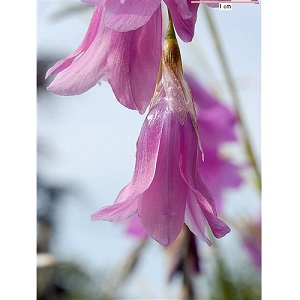
Dieramas are graceful plants, growing in clumps of
grass-like leaves, with tall arching stems of bell-shaped flowers in mid to
late summer. There are 44 species of
Dieramas, all coming originally from Southern Africa, many from mountainous
areas in the eastern side of the country.
They are therefore quite hardy and will survive well in most UK gardens
without too much care or attention.
Dieramas form underground corms and have evergreen
leaves. They grow slowly and take about
3 years to flower from seed, but are well worth the effort. They range in height from about 50cm to up to
1.5m when in flower, and the flowers bloom in shades of white, pink, red and
dark plum.
They look best grown in open borders or gravel gardens,
preferring to be in the ground rather than growing in pots. They look particularly good growing with
Agapanthus or alongside grasses. And
good next to water, but not in waterlogged soils. They grow and look their best where not
crowded by other plants.
Dierama pulcherrimum is widely available in the UK, with varieties
covering a range of colours. Plants grow
up to 1.5m when in flower, typically in mid-summer. Try Dierama ‘Album’, Dierama
‘Slieve Donard’ and Dierama ‘Dark Cerise’.
Dierama dracomantum flowers a little earlier in summer, with
pale pink flowers, and up to 1m in height.
Dierama trichorhizum is a dwarf form up to 60cm with pink flowers in mid
to late summer. Dierama reynoldsii is a tall variety, with wine red flowers in
mid to late summer up to 1.5m.
Propagation:
- By division: Mature
plants should be divided when flowering declines. The best time is typically in spring. Trim away any dead leaves, cut the remaining
leaves to half, then dig up and divide the clump. Be careful not to break the brittle
roots. Replant directly into the garden rather
than pots if possible. Plants take a
year or two to settle down and start flowering again.
- By seed: Sow the seed
anytime, typically in spring/early summer or autumn if you have a greenhouse. Sow the seed in free draining seed compost,
cover lightly with compost, keep at about 15°C and germination takes 3-6 weeks. If there is no germination, move the seed
tray into a fridge for 2 weeks and back out for germination. Seedlings need to be potted on and then grown
through a second season before planting in the final position. Flowering should start in the second or third
season, and can vary depending of the plants and where they are growing. Plants will self-seed in the right
conditions, and as they hybridise freely, the resulting plants may look
different from the parents. Seeds bought
from seed companies should generally flower reliably true to type, with some
natural variation.
Care:
Dieramas prefer to grow in sun and free draining soil. They benefit from an organic feed in spring
and watering during dry summer spells.
They do not do well in waterlogged soils in winter, so avoid planting in
these areas. Plants are not generally
troubled by pests and diseases. They may
be semi-evergreen in colder gardens and benefit from mulching or protection if
winter temperatures fall below -10°C.
|
|